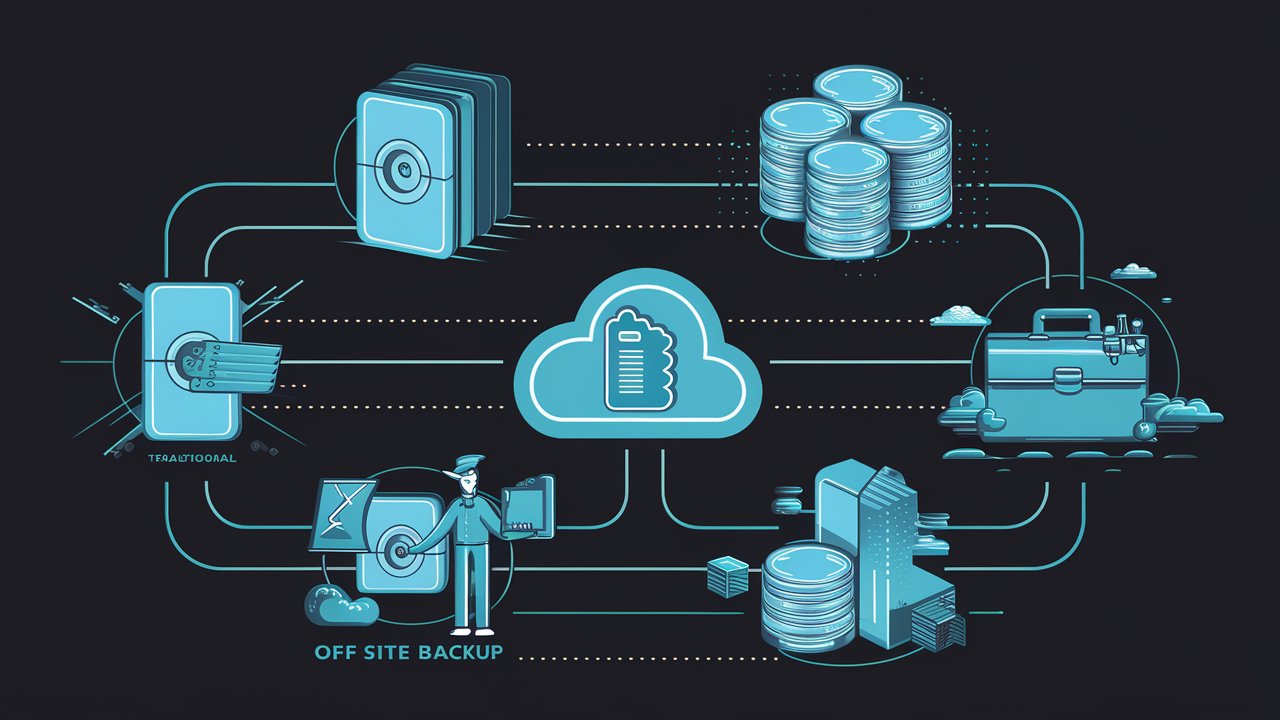Intro
In today's digital age, where vast amounts of information are stored electronically, the importance of regular data backups cannot be overstated. Data loss can occur due to various reasons, such as hardware failure, software corruption, malware attacks, or even human error. In this blog post, we will delve into the significance of regular data backups and how they play a crucial role in preventing data loss.

Understanding the Mechanics of Data Loss
Grasping the underlying mechanics of data loss is crucial for both individuals and businesses as we navigate through the digital expanse that holds our most valuable assets. Imagine the intricate network of data as a living ecosystem, constantly evolving, expanding, and unfortunately, susceptible to various threats that can lead to its demise. These threats range from the tangible, such as hardware malfunction and natural disasters, to the intangible, like software corruption and cyberattacks.
In this ecosystem, human error emerges as a surprisingly common predator, often underestimated in its ability to disrupt the balance. Whether it’s accidentally deleting files, spilling coffee on a laptop, or falling prey to phishing scams, the simplicity with which data can be compromised by our own hands is startling. Moreover, the increasing sophistication of malware and ransomware attacks adds another layer of complexity, making it imperative to understand not just the 'how' but also the 'why' behind protecting our digital territories.
This complex dance between data preservation and the multitude of ways in which it can be lost underscores the need for a proactive stance on data protection. It’s about recognizing the fragility of our digital footprints and taking informed steps to shield them from the unpredictable yet inevitable challenges they face. By delving into the mechanics of data loss, we arm ourselves with the knowledge needed to fortify our digital assets against the myriad of threats in today's interconnected world.

The Role of Regular Backups in Data Preservation
Embarking on the journey of data preservation, regular backups serve as our indispensable companions, safeguarding our digital lives against the unforeseen. Imagine venturing into an untamed wilderness – the digital landscape filled with potential hazards. In this scenario, regular backups act as our meticulously mapped routes back to safety, ensuring that no matter the peril faced on our journey, a pathway home, to our pristine data, remains intact.
This practice of routine data duplication is similar to an insurance policy for our digital assets, one that pays dividends in both tranquility and resilience. By establishing a habit of creating consistent copies and storing them apart from our primary data repositories, we construct a powerful defense mechanism. This bulwark stands vigilant against the specters of data degradation and loss, ready to restore harmony when chaos approaches.
Regular backups do not discriminate in their protection; they are democratic in their defense, preserving the entirety of our digital domain, from the monumental to the seemingly mundane. It's in this impartial approach to protecting our data that the true essence of data preservation is found. Each file, each byte, carries potential value, a piece of the larger puzzle that defines our digital existence. Regular backups recognize this basic worth, ensuring that no piece is lost to the void.
Thus, the role of regular backups in data preservation is not merely a technical task; it is a profound commitment to maintaining the integrity of our digital narratives. Through the disciplined practice of regular backups, we ensure that our digital legacies, our work, our memories, and our creations, remain inviolate, perpetually protected from the caprices of a digital realm fraught with uncertainty.

Different Backup Strategies and Their Benefits
Exploring the terrain of data backup strategies unveils a landscape rich with options, each tailored to navigate the unique challenges and needs presented by our digital environments. At the heart of this exploration lies three primary strategies: full backups, incremental backups, and differential backups. Each carries its arsenal of benefits, designed to optimize the preservation of our digital essence in subtle ways.
Full backups stand as the foundational pillars of data protection, offering a complete snapshot of our digital domains at specific moments in time. This comprehensive approach, while storage-intensive, grants the peace of mind that comes from knowing every byte of data is duplicated. It’s the digital equivalent of a detailed map, providing clear guidance back to the state of our data at the time of the backup.
Incremental backups, on the other hand, are the scouts of the backup world, charting changes as they occur. After the initial full backup, subsequent backups only capture what has changed, resulting in a series of incremental steps that lead back to full data restoration. This method is storage-efficient and swift, making it ideal for those navigating the rapid currents of data creation and modification.
Differential backups strike a balance between the thoroughness of full backups and the efficiency of incremental ones. Following an initial full backup, each differential backup records the changes made since that original snapshot. This strategy provides a more expedient recovery process than incremental backups, without requiring the storage capacity of full backups.
Each backup strategy embodies a unique approach to protecting our digital narratives, offering flexibility to adapt to varying data landscapes. By understanding and leveraging these strategies, we can tailor our defenses against data loss, ensuring our digital legacies withstand the test of time and technology.

Implementing a Foolproof Backup Plan
Crafting a foolproof backup plan surpasses the mere act of irregular data duplication; it embodies a comprehensive, disciplined approach designed to protect our most precious digital assets from the unforeseen. The cornerstone of this plan is the meticulous identification of critical data. Like a cartographer plotting the most vital landmarks, this step ensures that our most valuable digital treasures are never overlooked. Following this, we navigate the waters of backup frequency determination, a process similar to setting the sails for our journey through the digital expanse. This requires a keen understanding of our data’s dynamics, allowing us to adjust our backups to the rhythm of our digital life.
Selecting the right storage solutions is the next critical step, similar to choosing the strongest vessels to carry our precious cargo across turbulent seas. Whether it's cloud-based sanctuaries or physical fortresses, the aim is to find secure, accessible havens that align with our specific needs. However, the true test of our backup plan lies in its execution—regular testing of the backup process ensures that when storms hit, our digital realms can be swiftly and accurately restored, minimizing downtime and loss.
In this disciplined endeavor, the importance of vigilance cannot be overstated. A foolproof backup plan is not a set-and-forget affair; it's an ongoing commitment to the preservation of our digital legacy. Through systematic identification, careful planning, and regular testing, we fortify our digital worlds against the capricious nature of technology, ensuring our data's safety amidst the chaos of the digital age.

Real-World Consequences of Neglecting Data Backups
The fallout from neglecting regular data backups often unfolds in stories that serve as cautionary tales for the digital age. Picture a thriving business brought to its knees, not by market competition, but by a ransomware attack that encrypts years of critical data. Without updated backups, the only options are a costly ransom with no guarantee of data recovery or a painstaking rebuild of digital resources. Similarly, consider the individual who loses a lifetime of memories—photos, videos, personal documents—because of a hard drive failure. The impact is not just digital but deeply personal, affecting emotional well-being. These are not mere hypotheticals but realities faced by countless entities and individuals. The lessons gleaned underscore a sobering truth: the absence of regular, strategic data backups leaves our digital treasures vulnerable to a spectrum of calamities. In neglecting this essential safeguard, the risk isn't just losing data; it's losing a part of our digital identity and heritage.
Best Practices for Monitoring and Updating Data Backups
Embarking on a strict routine of vigilance is crucial in the realm of data backup management. To traverse this terrain effectively, a steadfast commitment to scrutinizing the health and fidelity of our backups is required. This involves conducting regular audits to confirm the integrity and completeness of our digital replicas, ensuring they truly mirror our current data landscape. Additionally, adapting our backup strategy to the evolving dynamics of our digital environments is crucial. This means revisiting and refining our backup schedules and methodologies in response to new data types, increased volumes, or shifts in the criticality of information.
Furthermore, integrating automation where possible can elevate the efficiency and reliability of these processes, minimizing human error and ensuring consistent execution. However, the human element remains indispensable; setting regular intervals for manual oversight represents our strategy with a layer of discernment and adaptability that automation alone cannot achieve.
Following these procedures helps to ensure that our digital legacies endure the ups and downs of the digital era by strengthening the resilience of our digital safeguards and improving our preparedness to respond to and recover from the unexpected.